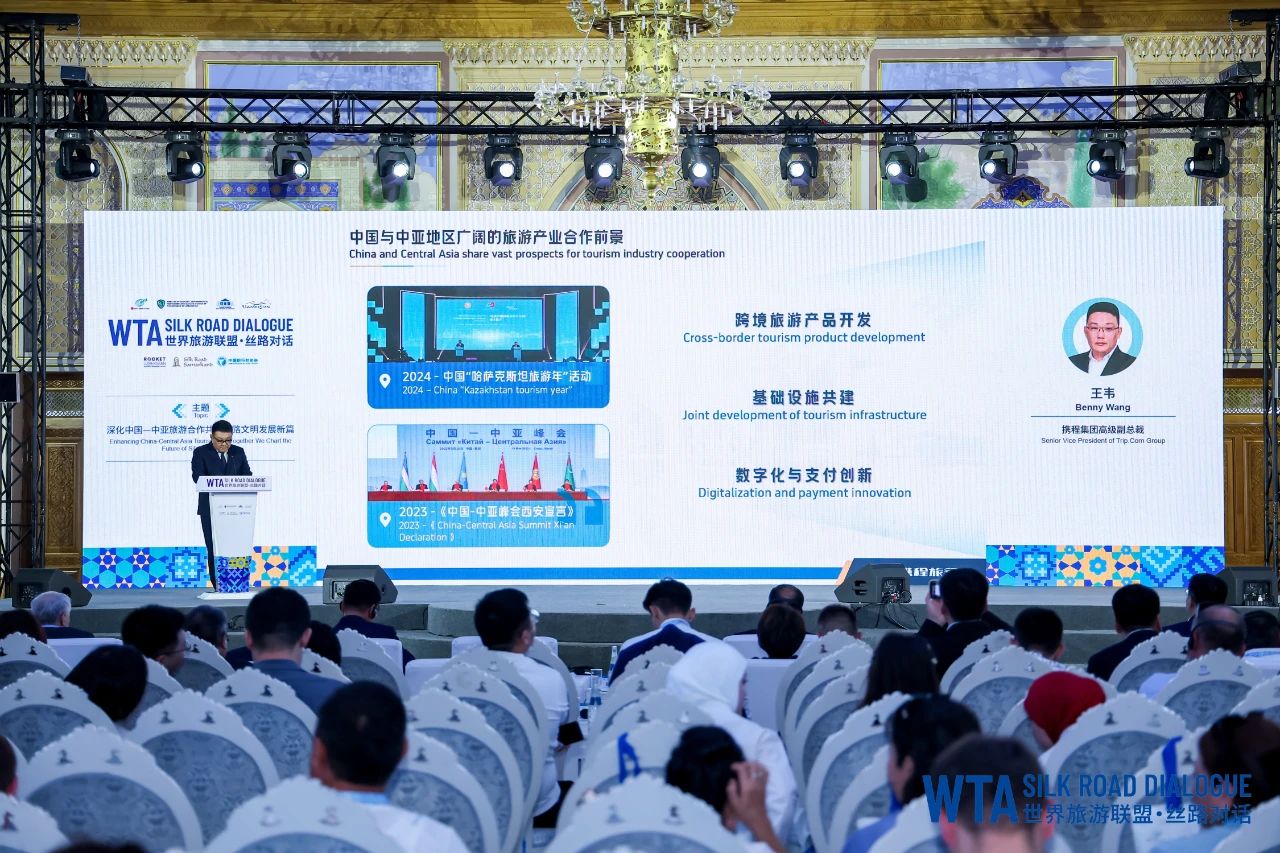2025-07-09
On July 3 (local time), the WTA·Silk Road Dialogue was held in Samarkand, Uzbekistan. Benny Wang, Senior Vice President of Trip.com Group, delivered a keynote speech titled "Enhancing China-Central Asia Tourism Ties Together We Chart the Future of Silk Road Heritage". Here are key takeaways from the speech:

Gathered here in Samarkand, a key hub of the ancient Silk Road, we come together to discuss the evolving trends in tourism between China and Central Asia. Having endured thousands of years of history, Samarkand has witnessed the blending of Eastern and Western civilizations and the continuous flow of merchants and travelers. Now, standing at the forefront of a new era, we are witnessing the vigorous development of tourism cooperation between China and Central Asia, opening a brand-new chapter in history.
In recent years, China’s outbound tourism market has shown a clear trend of diversified development. While traditional popular destinations like Japan, South Korea, Southeast Asia, Europe, and the U.S. continue to hold strong positions, Central Asia, with its unique cultural appeal and increasingly favorable policies, is quickly becoming a new hotspot for Chinese tourists. Taking Kazakhstan as an example, the number of Chinese tourists visiting the country reached 655,000 in 2024, a year-on-year increase of 78%, significantly surpassing pre-pandemic levels. Uzbekistan has also seen impressive growth in tourism, with 14,000 Chinese tourists visiting in the first two months of 2025, a year-on-year increase of over 50%. During the May Day holiday in 2025, Central Asia became a popular destination for Chinese tourists, with hotel bookings in cities like Samarkand and Almaty surging and tickets often selling out in advance. These figures clearly highlight the strong momentum of tourism cooperation between China and Central Asia, signaling the start of a new golden era in bilateral tourism relations.
The increase of Chinese tourists traveling to Central Asia can be attributed to several factors. First, the continuous introduction of favorable policies has created a strong foundation for tourism cooperation. Since November 2023, the Mutual Visa Exemption Agreement between China and Kazakhstan has taken effect, allowing citizens of both countries to stay visa-free for 30 days. Uzbekistan implemented a 10-day visa-free policy for Chinese tourists in 2021, and the China-Uzbekistan Visa Exemption Agreement took effect on June 1, 2025, extending the stay period to 30 days. Kyrgyzstan and Tajikistan are also actively attracting Chinese tourists through facilitation measures such as e-visas. Second, the continuous improvement of transportation networks has significantly reduced the travel time between the two regions. The number of direct flights between China and Central Asia has increased significantly, with cities like Ürümqi, Xi’an, and Chengdu now offering direct flights to major Central Asian destinations. Additionally, Central Asia’s unique tourism resources hold strong appeal for Chinese tourists. Kazakhstan’s vast grasslands, Uzbekistan’s historically rich Silk Road cities, Kyrgyzstan’s alpine wonders, and Tajikistan’s majestic Pamir Plateau all cater to the Chinese desire for natural beauty and cultural exploration.
A particularly noteworthy trend is the growing influence of young travelers, especially those from Generation Z (born after 1995), who have become a major driving force behind the tourism boom in Central Asia. Surveys reveal this demographic leads all age groups in terms of per capita travel frequency. As digital natives, deeply engaged with social media, they have a unique ability to spot and amplify emerging tourism trends. The recent rise in travel styles like "Special Forces-Style Tourism" "spiritual healing temple visits", and "in-depth Citywalk" can largely be attributed to this group’s preferences. Research shows post-95s travelers tend to favor off-the-beaten-path destinations, seeking more immersive and authentic experiences. Central Asia’s combination of affordable travel packages, rich historical and cultural heritage, and the cultural resonance of the Silk Road perfectly aligns with their preferences, making the region a favorite among young Chinese tourists.
This surge in Chinese tourists visiting Central Asia is being reciprocated by equally strong growth in Central Asian travelers to China, with their travel motivations showing increasing diversity. Leisure and business travel remain major components, with the rapid growth of trade between China and Kazakhstan/Uzbekistan leading to more frequent business trips and conference activities. Cultural and tourism activities are also gaining popularity, with Central Asian visitors increasingly drawn to the historical resources of cities like Xi’an, Beijing and Shanghai, as well as the spectacular natural scenery of Xinjiang. Data from Trip.com shows that from January 1 to June 9, 2025, Shanghai – one of China’s most important inbound tourism destinations – saw a 52.66% year-on-year increase in total arrivals from Kazakhstan, with total tourism spending up 71.23%. Leisure travelers saw a 74.52% increase in arrivals and an 86.06% growth in spending, while business travel experienced a 26.57% rise in arrivals and a 51.26% increase in spending, indicating a significantly stronger growth in leisure tourism consumption.
Meanwhile, the spending patterns of Central Asian visitors in China are undergoing positive changes, shifting from single-purpose shopping to more diversified consumption. New tourism formats, like shopping tourism and medical tourism, are quietly emerging. From January to May 30, 2025, the Horgos International Border Cooperation Center on the China-Kazakhstan border recorded 3.893 million border crossings, an 87.2% year-on-year increase, while cross-border e-commerce trade volume reached 28.05 billion yuan, up by 890%. Sales at duty-free shops also showed significant growth. Medical tourism is gaining popularity, with initiatives like the kidney disease research collaboration between the Second Affiliated Hospital of Xi’an Jiaotong University and medical institutions in Uzbekistan, as well as the introduction of traditional Chinese medicine cultural experiences in Almaty, breathing new life into bilateral tourism cooperation.
Looking ahead, China-Central Asia tourism cooperation holds immense potential, having already achieved landmark results in cross-border tourism product development, infrastructure co-construction, and digital payment innovation. However, we must also acknowledge the challenges that remain, such as language barriers, cultural differences, inadequate signage, and infrastructure gaps, all of which will require joint efforts to address.
To more effectively address these challenges and achieve sustainable development of bilateral tourism cooperation, China and Central Asian countries need to work collaboratively. In terms of language services, Central Asian countries could further expand the coverage of Chinese signage at key locations such as tourist attractions, hotels and transportation hubs, while also enhancing the training of Chinese-speaking tour guides. Regarding service quality improvement, Central Asian countries could draw on China’s experience in tourism service standardization, improve tourism service standards, and introduce internationally renowned hotel management brands to enhance professional service levels. Chinese tourism enterprises could also participate in the operation and management of Central Asian hotels and scenic spots through investment and cooperation, sharing their advanced management experience and service concepts. At the same time, both sides should commit to green development principles, promote eco-tourism, and prioritize the protection of Central Asia’s unique natural and cultural heritage in tourism resource development, ensuring a positive balance between economic growth and environmental protection.

Standing here in the beautiful, historic city of Samarkand, let us come together to envision a bright and prosperous future for China-Central Asia tourism cooperation. With the implementation of visa exemption agreements between China and Central Asian countries, the advancement of the China-Kyrgyzstan-Uzbekistan railway project, and the continuous hosting of national tourism year events, people-to-people exchanges will become more frequent and the tourism market will further expand. As a leading global enterprise, Trip.com Group has full confidence in the growth of tourism cooperation between China and Central Asia and is eager to contribute to fostering more extensive and in-depth collaboration. Let us work hand in hand to transform the historical bond of the Silk Road into a driving force for tourism development, allowing the ancient Silk Road civilization to shine with renewed splendor in the new era.